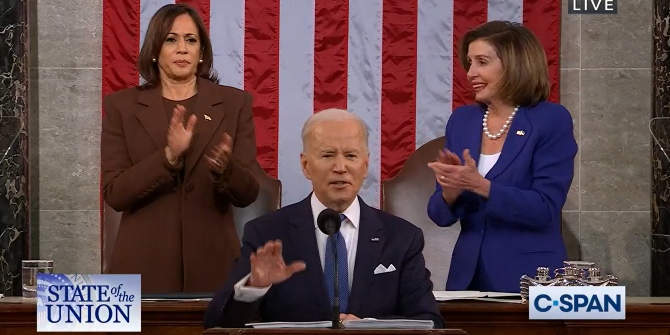 With his approval numbers dipping below 40 percent, President Joe Biden needed a “reset” from his State of the Union address last evening. Did he accomplish that goal? In this Q&A, Thomas Gift analyzes Biden’s prime time speech before Congress, memorable moments from his remarks, and whether Biden can build on his momentum in time to turn around Democratic fortunes for the 2022 midterms.
With his approval numbers dipping below 40 percent, President Joe Biden needed a “reset” from his State of the Union address last evening. Did he accomplish that goal? In this Q&A, Thomas Gift analyzes Biden’s prime time speech before Congress, memorable moments from his remarks, and whether Biden can build on his momentum in time to turn around Democratic fortunes for the 2022 midterms.
What was Biden’s central challenge heading into the State of the Union? Did he meet it?
Biden’s challenge was twofold: he of course needed to tout the White House’s achievements; but he also had to acknowledge the real problems that the US is confronting on the economy, COVID-19 and infrastructure, without coming off as too pessimistic or too defensive. So it was all about striking a balance—and overall I think he succeeded.
On the economy, Biden emphasized strong GDP and employment growth, but insisted that he understood the pain of inflation reaching a 40-year peak. On COVID-19, he highlighted his pandemic relief bill and progress on immunizations, but made clear that the country still has a long way to go in reducing infections. On domestic policy, he promoted his bipartisan infrastructure bill, but conceded the need to make inroads on climate change, universal pre-K, and childcare.
When it came to foreign policy, Biden’s overarching message was that he’s wielding American power responsibly. Unsurprisingly, Russia and Ukraine took central focus, but Biden only mentioned Afghanistan in passing.
What did you make of Biden’s remarks on the Ukraine-Russia conflict?
By far, Biden’s comments on Ukraine were the most politically consequential of the evening. According to recent polling, only about 33 percent of Americans approve of Biden’s handling of the conflict to date. So Biden needed to persuade skeptics that he’s effectively managing the tensions and advancing America’s interests in Eastern Europe.
Biden framed his remarks with familiar themes: ensuring that democracy prevails over authoritarianism, and the imperative of partnering with Western allies on shared foreign policy goals. He said that Russia underestimated the extent of global unity in rebuking Putin’s attack on Ukraine, and spoke forcefully about how countries that violate national sovereignty will “pay a price.”
Biden didn’t pull any punches against Moscow, and this was undoubtedly the most unifying part of his address. That said, the situation in Ukraine is so precarious at the moment that it’s hard to make any firm forecasts about the medium- to long-term political implications for the White House.
Inflation featured prominently in the speech. How did Biden handle the issue?
Inflation has been whipsawing through the US economy for months at rates not seen for decades, and most Americans blame Biden for the problem. Early in his term, Biden’s team largely ignored warnings about how large infusions of federal spending could trigger a wage-price spiral. When inflation did spike, the White House shrugged it off as temporary.
Last night, Biden did convey more effectively that he grasped the enormity of the problem. At the same time, there were few specifics in his plan (besides the standard Democratic fare of price-controls on items like prescription drugs and housing)—which may just reflect the reality that there’s no silver bullet.
It’s worth noting new reasons to be pessimistic on the inflation front. Imposing sanctions on Russia won’t do anything to help curb rising price levels (especially on oil), in the US or globally. For Biden, who pledged a “foreign policy for the middle class,” a surging consumer price index—exacerbated by an overseas conflict — is a serious political liability.

Image credit: C-SPAN
Will Biden’s address be enough to improve the fate of Democrats in the 2022 midterms?
Biden is hoping for a “reset,” and recently, State of the Union addresses have granted presidents short-term bump in approvals. Still, projections look grim for the White House and Democrats generally heading into the November midterms. Biden’s favorability numbers are hovering in the upper 30s, and the split between Americans who want Republicans instead of Democrats in charge of Congress is about 10 percentage points.
Biden’s address was useful rhetorically for outlining a broad agenda and for building political momentum. But ultimately, he needs to deliver on his promises. Much of how the Ukraine-Russia conflict unfolds will be outside of Washington’s control, and the administration still confronts a Republican opposition on Capitol Hill that’s intent on obstructionism.
If Biden wants to defy expectations and reverse Democratic fates between now and the November midterms, he needs to focus on narrow, manageable goals that build intra-party consensus. Until now, Biden’s record in forging those kinds of deals has been mixed—at best.
- These remarks are based in part on an interview by Thomas Gift for CNN on March 2, 2022.
Please read our comments policy before commenting.
Note: This article gives the views of the author, and not the position of USAPP – American Politics and Policy, nor the London School of Economics.
Shortened URL for this post: https://bit.ly/3KaOw7c
About the author
 Thomas Gift – UCL
Thomas Gift – UCL
Thomas Gift is Associate Professor of Political Science at UCL, where he is director of the Centre on US Politics (CUSP).






